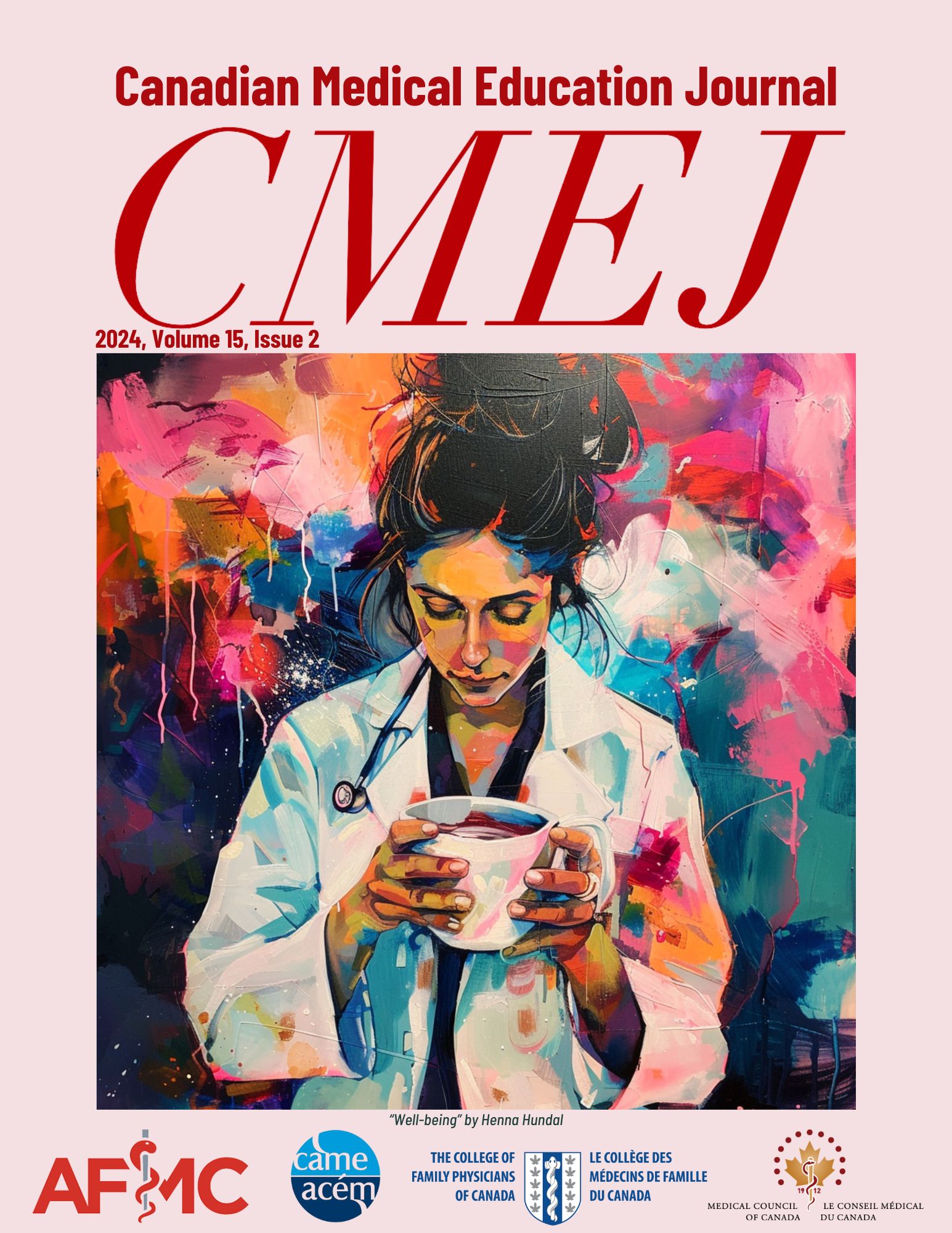Six ways to get a grip on patient and family centered care during the undergraduate medical years
DOI:
https://doi.org/10.36834/cmej.71342Abstract
Patient and family-centered care and patient engagement practices have strong evidence-based links with quality and safety for both patients and health care providers. Expectations for patient and family-centered care have advanced beyond hearing the patient perspective and taking patient wishes into account. A participatory approach including patients as partners in their care journey is expected, but attitudes toward patient and family-centered care remain barriers in practice. As health service organizations shift from a system-centered approach to a patient and family-centered care delivery model, black ice occurs. In this Black Ice article, we present some practical tips for medical educators to improve opportunities for medical students to develop knowledge, attitudes, and skills that support patient and family-centered care.
Downloads
References
Royal College of Physicians and Surgeons of Canada. CanMeds: medical expert [Internet]. 2015. Available from: http://www.royalcollege.ca/rcsite/canmeds/framework/canmeds-role-medical-expert-e. [Accessed on Sept 19, 2020].
Canadian Interprofessional Health Collaborative (CIHC). A national interprofessional competency framework. [Internet]. 2010. 1-32 p. Available from: http://ipcontherun.ca/wp-content/uploads/2014/06/National-Framework.pdf . [Accessed Sept 8, 2021].
Institute for Patient- and Family-Centered Care. Advancing the practice of patient- and family-centered care in hospitals: how to get started 2017. Bethesda, USA; p1-22. Available from: https://www.ipfcc.org/resources/getting_started.pdf. [Accessed on Oct 17, 2020].
Dagnone T. For patients’ sake: patient first review commissioner’s report to the Saskatchewan Minister of Health. Patient First. Saskatchewan Ministry of Health; 2009. Available at https://vibdoc.com/pf-commissioners-report.html [Accessed on Oct 8, 2021].
Parent K, Jones K, Phillips L, Stojan JN, House JB. Teaching patient- and family-centered care: integrating shared humanity into medical education curricula. AMA J Ethics 2016;18(1):24-32. https://doi.org/10.1001/journalofethics.2017.18.1.medu1-1601 DOI: https://doi.org/10.1001/journalofethics.2017.18.1.medu1-1601
Carman KL, Dardess P, Maurer M, et al. Patient and family engagement: a framework for understanding the elements and developing interventions and policies. Health Aff; 2013 Feb;32(2):223-31. https://doi.org/10.1377/hlthaff.2012.1133 DOI: https://doi.org/10.1377/hlthaff.2012.1133
Lloyd B, Elkins M, Innes L, Lloyd B, Elkins M. Barriers and enablers of patient and family centred care in an Australian acute care hospital: perspectives of health managers Patient exp j. 2018;5(3):9. https://doi.org/10.35680/2372-0247.1270 DOI: https://doi.org/10.35680/2372-0247.1270
Rivoire, E. Module 7a: patients as partners: engaging patients and families: patient and family centred care. Emanuel L, Taylor L, Hain A, et al., editors. Patient Safety Institute. 2017;p. 1-49. Available from: https://www.patientsafetyinstitute.ca/en/education/PatientSafetyEducationProgram/PatientSafetyEducationCurriculum/Pages/Engaging-Patients-and-Families-Patient-and-Family-Centred-Care.aspx. [Accessed Sept 28, 2021].
Doyle C, Lennox L, Bell D. A systematic review of evidence on the links between patient experience and clinical safety and effectiveness. BMJ Open. 2013 Jan 1;3(1):e001570. https://doi.org/10.1136/bmjopen-2012-001570 DOI: https://doi.org/10.1136/bmjopen-2012-001570
Teare GF, Keller M, Hall D. Bringing together research and quality improvement: the Saskatchewan approach. Healthc Q/ 2018 Jun 12;21(Special Issue):56-60. https://doi.org/10.12927/hcq.2018.25637 DOI: https://doi.org/10.12927/hcq.2018.25637
Illingworth R. What does "patient-centred" mean in relation to the consultation? Clin Teach. 2010 Jun;7(2):116-20. https://doi.org/10.1111/j.1743-498X.2010.00367.x DOI: https://doi.org/10.1111/j.1743-498X.2010.00367.x
Committee on Accreditation of Canadian Medical Schools (CACMS). CACMS standards and elements: standards for accreditation of medical education programs leading to the MD degree. 2020;(February 2019). Ottawa, Canada; p. 1-23. Available from: https://cacms-cafmc.ca/sites/default/files/documents/CACMS_Standards_and_Elements_AY_2021-2022.pdf [Accessed on Oct 8, 2021].
Institute for Patient- and Family-Centered Care. Applying patient- and family-centered concepts to bedside rounds. 2015. Bethesda, USA; p. 1-5. Available from: https://www.ipfcc.org/resources/PH_RD_Applying_PFCC_Rounds_012009.pdf. [Accessed Sept 22, 2021].
Institute for Patient- and Family-Centered Care. A checklist for attitudes about partnering with patients and families (part vi). 2017. Bethesda, USA; p.17. Available from: https://www.ipfcc.org/resources/getting_started.pdf. [Accessed on Oct 17, 2020].
Downloads
Published
How to Cite
Issue
Section
License
Copyright (c) 2023 Krista Baerg, Tara Anderson, Heather Thiessen

This work is licensed under a Creative Commons Attribution-NonCommercial-NoDerivatives 4.0 International License.
Submission of an original manuscript to the Canadian Medical Education Journal will be taken to mean that it represents original work not previously published, that it is not being considered elsewhere for publication. If accepted for publication, it will be published online and it will not be published elsewhere in the same form, for commercial purposes, in any language, without the consent of the publisher.
Authors who publish in the Canadian Medical Education Journal agree to release their articles under the Creative Commons Attribution-Noncommercial-No Derivative Works 4.0 Canada Licence. This licence allows anyone to copy and distribute the article for non-commercial purposes provided that appropriate attribution is given. For details of the rights an author grants users of their work, please see the licence summary and the full licence.











